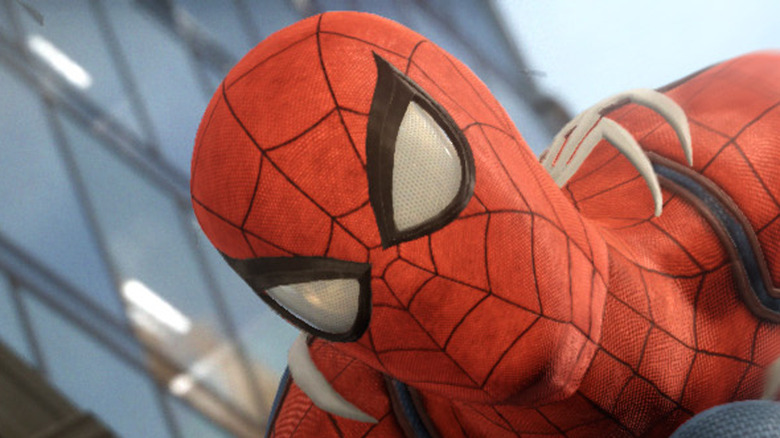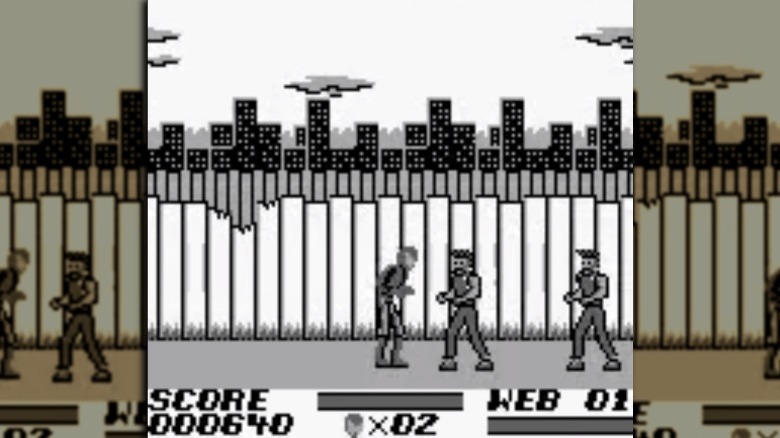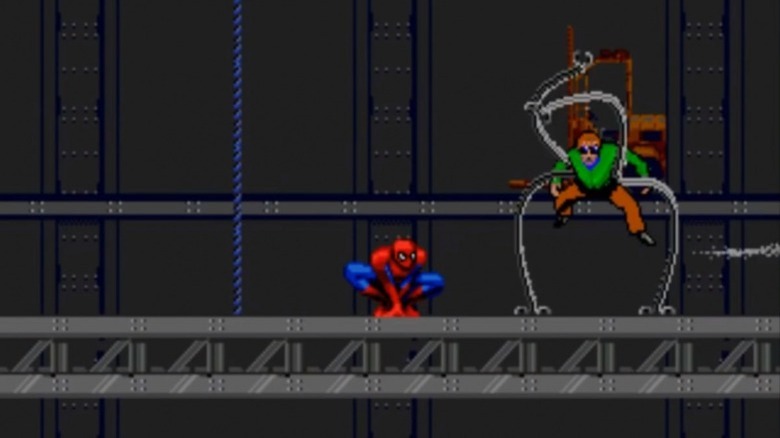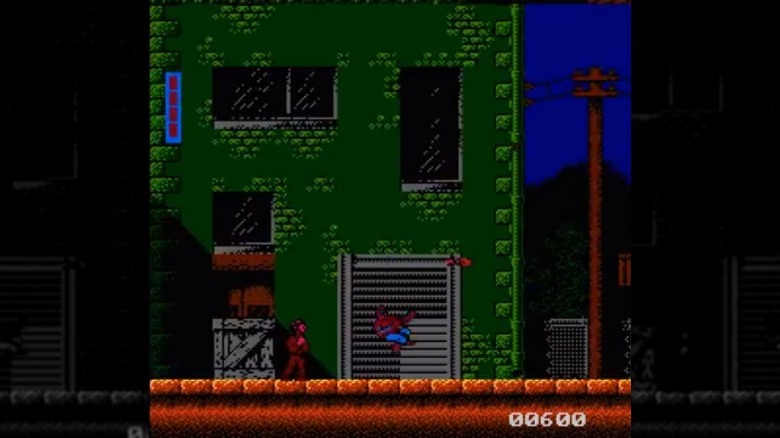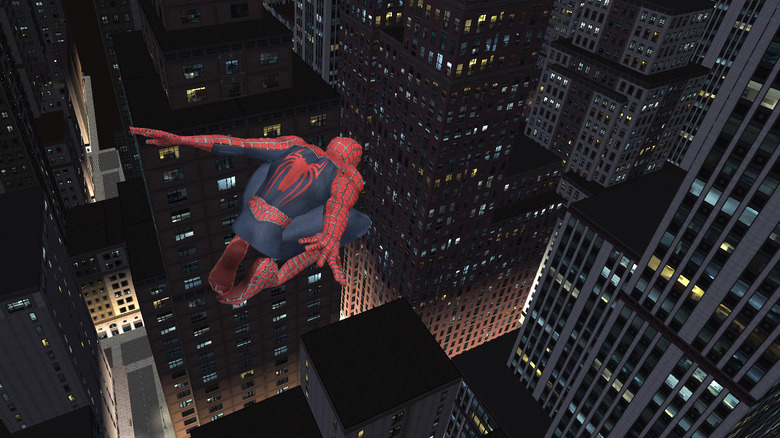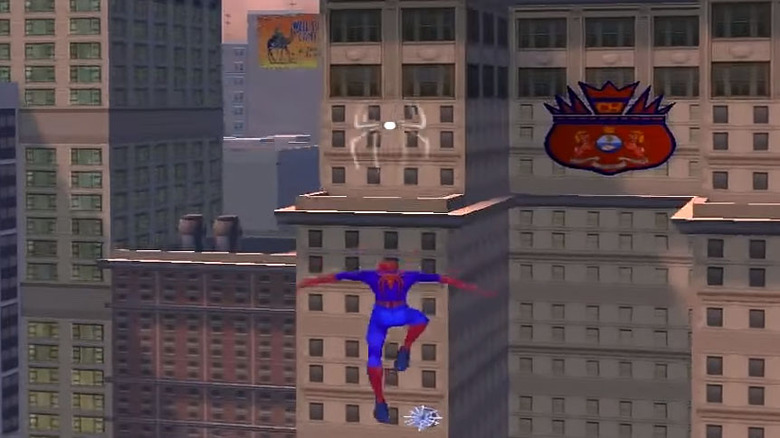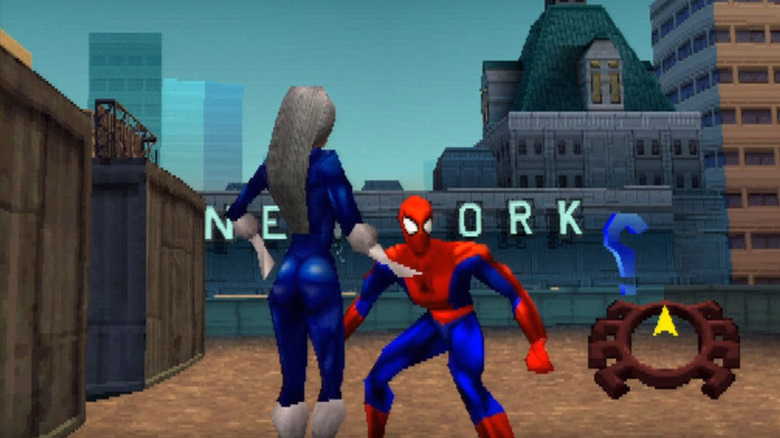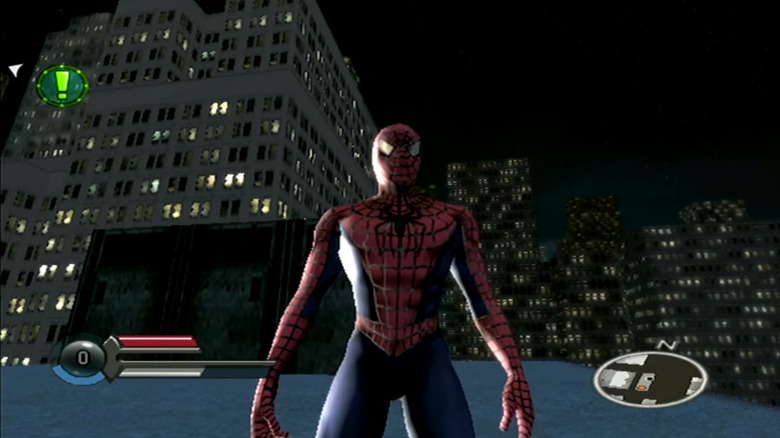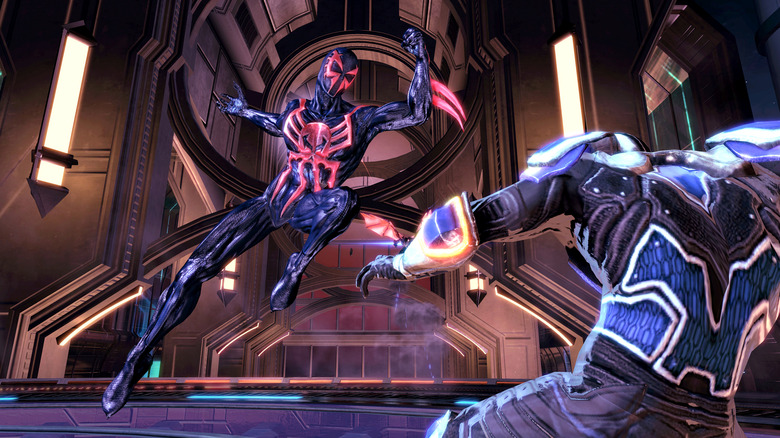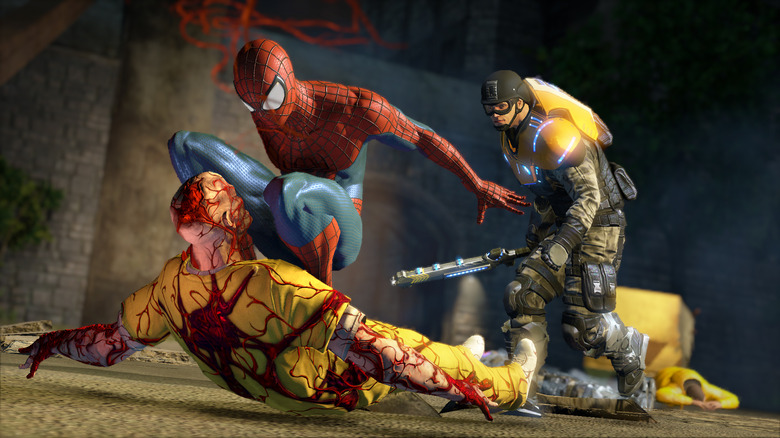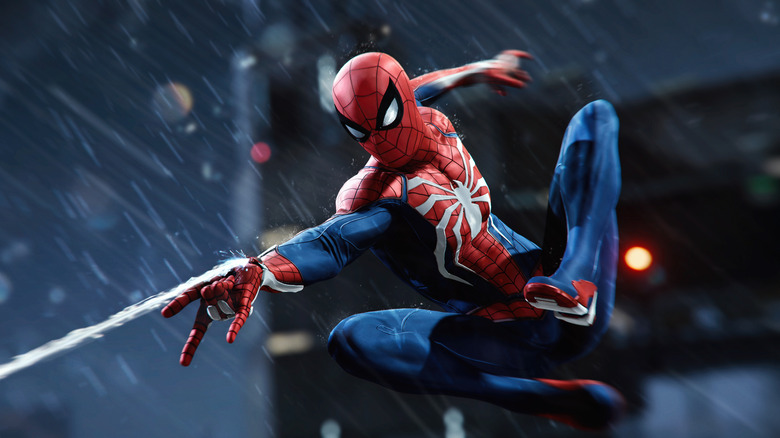The 5 Best And 5 Worst Spider-Man Games
Oh, Spider-Man. He can do whatever a spider can — and so much more. Spinning webs of any size? Swinging from a thread? Catching thieves just like flies? He's got it all covered. Starring in a top-tier video game, though? That's proved to be a little bit trickier.
There have been Spider-Man video games for almost as long as video games have been a thing, starting with 1982's Atari 2600 outing, the appropriately titled Spider-Man, all the way through the present day. Here's a little secret, though: most of them are thoroughly mediocre. Run-of-the-mill platformers. Microtransaction-heavy mobile games. Repetitive brawlers. Quick Hollywood cash-ins. Spidey's been in them all.
Every now and then, however, a Spider-Man game stands out, either because it's unusually good or because it's unfathomably bad. We've got a round-up of both. Enjoy this quick look at the best and worst of Spider-Man's headlining roles and try not to get discouraged. Spidey's seen some dark days, but from all indications, his future is very, very bright.
WORST: The Amazing Spider-Man (Game Boy)
1990 was a big year for everyone's favorite webslinger. That was the year when superstar artist Todd McFarlane got his very own Spider-Man title, the aptly named Spider-Man, which sold a staggering 2.5 million in sales and helped transform comic books into a creator-driven industry. It's also the year when Spidey got his first portable game, the Nintendo Game Boy's The Amazing Spider-Man.
Here's the problem: while McFarlane's book is hit or miss, depending on your tolerance for '90s-style Marvel comics, The Amazing Spider-Man flat-out sucks. Rare, the company that developed the game, went on to make a number of bona fide classics, including the Donkey Kong Country series and the essential shooter GoldenEye 007. The Amazing Spider-Man was only Rare's second Game Boy game, though, and boy does it show. The art isn't suited for the Game Boy's small, monochromatic screen, so both Spider-Man and his foes blend into the background, making them hard to see.
At least it's short. If you know what you're doing, the game only lasts about 20 minutes, and that might be the best thing about it. Walking slowly through nondescript New York locales, punching any enemies that you come across, gets old pretty quick. It's not fun, and even worse, it's not very Spider-Man, either. While Rare tried to include as many of Spidey's powers as it could given the Game Boy's limited button selection, the controls don't really work.
BEST: The Amazing Spider-Man vs. the Kingpin (Sega Master System)
On the other hand, 1990 also saw the release of The Amazing Spider-Man vs. the Kingpin, which is by far the best of Spider-Man's early titles. Originally released for the Master System and later ported to all of the then-existing Sega platforms, Spider-Man vs. the Kingpin has everything you'd want from an early '90s Spider-Man adventure — and a little extra.
Unlike other games, Spider-Man vs. the Kingpin fully captures all of the web-head's powers. Want to climb up walls, swing through the air, sling webs at enemies, or use your spider sense to avoid oncoming attacks? You can. In a time when most platformers only let you run, jump, and maybe punch, that was a huge deal. The Sega Genesis version of the game gives Spider-Man's alter ego, Peter Parker, a nod, too: you can visit Peter's apartment between stages to recoup.
The Amazing Spider-Man vs. the Kingpin even looks like the comics, especially the souped up Sega-CD version, and features a Marvel-worthy storyline to match: the Kingpin has convinced the public that Spider-Man is trying to blow up the Big Apple, and Spidey has 24 hours to defuse the bombs and clear his name. Allegedly, two thirds of all Mega Drive/Genesis owners had the game at some point, and it's easy to see why. With its fluid controls and non-linear campaign, The Amazing Spider-Man vs. the Kingpin remains the gold standard for Spider-Man platformers.
WORST: Spider-Man: Return of the Sinister Six (NES)
Spider-Man's first appearance on a Sega machine was a triumph, but his inaugural outing on the Nintendo Entertainment System was a flat-out bust. Not only did Spider-Man: Return of the Sinister Six come out in 1992 — a full year after the Super Nintendo hit the USA — but technically-speaking it's a mess that's plagued by unstable frame rates, massive slowdowns, and clumsy controls.
It's also generic to a fault. In Return of the Sinister Six, Spider-Man gets by through a combination of jumping, punching, kicking and, if he happens to find a canister of web fluid, flinging projectiles at enemies. Spider-Man can also swing on webs, but honestly, it's better not to. Return of the Sinister Six makes it hard to tell which objects Spidey's webs can latch on to, shooting a web (which requires players to hit the A and B buttons at the same time) is cumbersome, and there's no actual benefit to doing so. You can make it through the entire game without using Spider-Man's signature power more than once.
There's no wall-crawling, no spider-sense, and no wisecracks. In fact, in Return of the Sinister Six, Spider-Man can't even stay on top of a ladder reliably. Even worse, you only get one life and one continue. Tedious? Try infuriating.
BEST: Spider-Man 2 (PlayStation 2)
Video games based on movies get a bad rap. Not all of 'em are good, but occasionally something great sneaks through. Don't believe us? Take a look at GoldenEye 007, The Chronicles of Riddick, Aladdin, The Warriors, or, naturally, Treyarch's Spider-Man 2.
Loosely based on Sam Raimi's and Tobey Maguire's second Spidey flick, Spider-Man 2 is, in many ways, your typical mid-'00s open-world game. Most of the time, you'll simply cruise the New York streets en route to your next mission objective, pausing along the way to stop random crimes. So far, so Grand Theft Auto. But in Spider-Man 2, you don't need to jack a car to get around: instead, try traveling via web-shooter. The physics-driven web-swinging system, in which your webs need something to connect to if you're going to swing from 'em, is the cornerstone of the entire game. Spider-Man has never felt so vibrant, versatile, mobile, or alive — at least not on a video game console.
Even better, if you like Spider-Man 2, Activision released Ultimate Spider-Man a mere year later. It's not as innovative as Spider-Man 2, but it does have some stunning cell-shaded graphics and a storyline written by Ultimate Spider-Man co-creator Brian Michael Bendis himself. The two games go together nicely, and they're both worth checking out. Trust us: Spider-Man 2's web-slinging never gets old.
WORST: Spider-Man 2 (PC)
If you read our gushing recap of Spider-Man 2 and thought to yourself, "huh?" then we've got some bad news: chances are, you played the PC version of the game, and not the console one. That means that, instead of the web-swinging open-world paradise that everyone still raves about, you had to endure a dumbed-down "kid friendly" retelling of the feature film with a bad camera, bad controls, bad graphics, bad physics and, well, bad everything.
It's not just a stripped-down port. This version of Spider-Man 2 is an entirely different game made by a completely different studio, and it feels explicitly designed to disappoint PC-bound players. Not only is the console version so good that it's pretty much impossible not to be jealous if you're stuck with the inferior product, but Spider-Man 2's marketing materials didn't let on that the PC edition isn't the same as the console version. If you read the reviews for the GameCube, PlayStation 2, or Xbox installments and decided to give the PC version a whirl, you were screwed, plain and simple.
BEST: Spider-Man (PlayStation)
In 2000, something spectacular happened: Spider-Man finally made the leap into 3D, leaving his legacy of mediocre platformers in the past (or, at the very least, relegating those games to handheld consoles). The result is one of the very best Spider-Man games ever made. The PlayStation-era graphics look dated by today's standards, and the game might be a little too easy for platformer veterans, but Spider-Man gets so much right that it's easy to overlook any flaws.
See, Spider-Man was built by the same studio that made Tony Hawk's Pro Skater 2 (in which Spider-Man makes a cameo), and features that game's unrestricted sense of movement. Finally, players could web-sling their way through New York City, and while Spider-Man isn't an open-world game — that came a little bit later — it's hard to describe just how cool it felt to unleash Spidey's signature moves in 3D. Spider-Man was the first game to nail Peter Parker's superpowers, and it was exhilarating.
The game's ample helpings of fan-service doesn't hurt, either. Spider-Man co-creator Stan Lee narrates the game's tutorial, while Spider-Man Unlimited actor Rino Romano returned to voice Spider-Man and Peter Parker. All of Spider-Man's major supporting cast members appear (plus a few other cameos), and the game's digital New York is full of Spider-Man comic books to collect, too. Before Spider-Man, we didn't know if there'd ever be a truly great superhero game. After, the answer was clear.
WORST: Spider-Man 3 (Wii)
Look, after Spider-Man 2, pretty much anything less than brilliance would be a major let-down. In that respect, Spider-Man 3 doesn't disappoint. The beloved web-swinging system is back (with a few small adjustments) and the digital recreation of New York City is bigger and deeper than ever before, but the spark that made Spider-Man 2 so appealing is missing. Spider-Man 3 is, like its source material, thoroughly mediocre.
That's if you're playing on the Xbox 360 or PlayStation 3, of course. The Wii edition of the game is an entirely different story. Developed by Vicarious Visions, not Treyarch, the Wii's Spider-Man 3 is a garbled and ugly mess. The city looks like a relic from the Nintendo 64 era, while the characters move like spandex-clad mannequins.
Worst of all, though, are Spider-Man 3's motion controls. Flicking your left and right wrists in sequence to shoot Spidey's webs is fun in theory, and once you get the hang of it it really does feel like you're wearing your own web-shooters. It's also incredibly tricky, and you'll be tempted to give up many times before you've got the whole system nailed down. As far as combat goes, well, using the Wii remote and nunchuk controller to throw individual punches isn't just inaccurate: it's exhausting, and combined with a camera that steadfastly refuses to show you the action, you'll likely be pulling your PS2 out of the closet for another go with Spider-Man 2 well before the credits roll.
BEST: Spider-Man: Shattered Dimensions (Xbox 360/PlayStation 3)
When one Spider-Man isn't getting the job done, try adding another. And another. And another. That's the hook behind Spider-Man: Shattered Dimensions, a 2010 action game that doesn't really contain any major innovations, but makes up for it with some fan-friendly dimension-hopping and all kinds of Easter eggs for die-hard webheads.
After Mysterio shatters a mystical artifact called the Tablet of Order and Chaos, long-time Spider-Man ally Madame Web enlists Peter Parker's help to cruise the multiverse and get the pieces back. Actually, Web reaches out to four different Peter Parkers, each one of which comes from the comic books. Every Spider-Man plays differently — Spider-Man Noir relies on stealth, Spider-Man 2099 comes with all kinds of futuristic gadgets, and Ultimate Spider-Man uses his symbiote suit to decimate foes — and mixing and matching powers with various situations keeps the game fresh for a lot longer than it should be.
Is it silly? Oh, absolutely, but Shattered Dimensions is just that kind of game. Every Spider-Man is voiced by a different actor from Spidey's history. Neil Patrick Harris, who played Peter in MTV's 2003 animated series, voices regular Spider-Man, for example while Spider-Man 2099's Dan Gilvezan returns to the red-and-blue spandex for the first time since Spider-Man and His Amazing Friends ended back in the '80s. Shattered Dimensions isn't an essential game, but if you're a Spider-Man geek you'll find plenty of sticky, webby goodness to enjoy.
WORST: The Amazing Spider-Man 2 (PlayStation 4/Xbox One)
Despite what you might've heard, The Amazing Spider-Man 2 isn't the worst Spider-Man video game ever made. Given the competition, though, that's not saying much. Critics slammed Marc Webb's The Amazing Spider-Man 2 feature film for stuffing too many ideas into the script without really exploring any of them. The video game spin-off suffers from the same flaws. The story by veteran comic book writer Christos Gage is less of a coherent narrative and more of a greatest hits collection of Spider-Man villains. Combat makes a half-hearted stab at depth before descending into button-mashing. The Amazing Spider-Man 2's map is big, but it lacks interesting things to do or see.
Of course, the whole thing is bogged down with glitches and bugs, too. The Amazing Spider-Man 2 is a bad game, but it's also pretty standard for a rushed, mid-budget cinematic tie-in. So why all the hate? It comes down to The Amazing Spider-Man 2's psychological impact. "I've accepted that there's probably never going to be a truly great Spider-Man game," Polygon critic Justin McElroy writes. "If the dispiriting The Amazing Spider-Man 2 is any indication, [publisher] Activision and [developer] Beenox may have reached the same conclusion."
Thankfully, they were wrong.
BEST: Marvel's Spider-Man (PlayStation 4)
Believe the hype: 2018's PlayStation 4-exclusive Marvel's Spider-Man is the Spidey simulator you've been waiting for. Taking cues (and the combat system) from Batman: Arkham Asylum, Insomniac Games has crafted the definitive Spider-Man video game. It basically takes the best parts of every past Spider-Man game and mashes them all together. Spider-Man 2's explorable New York and physics-based web-swinging? Check. The Amazing Spider-Man vs. the Kingpin's part-time focus on Spider-Man's civilian alter-ego? Check. Shattered Dimensions' crowd-pleasing fan-service? Triple check.
Even better, though, is how Spider-Man effortlessly captures the character's personality. There's a dedicated button for greeting pedestrians with finger-guns and high-fives, putting the "friendly" back in "friendly neighborhood." Spidey can snap selfies while swinging through the city, and his wisecracks strike the perfect balance between annoying and legitimately funny. Spider-Man isn't tied to any existing continuity, either, giving Insomniac free rein to streamline and reconfigure Peter Parker's world in a way that feels both respectful and fresh (turning former Daily Bugle editor J. Jonah Jameson into the host of his own InfoWars-like podcast is a stroke of genius).
Spider-Man isn't perfect, of course. The Arkham influence makes some sections of the game feel a little too familiar, and it suffers from the same glut of stuff as many modern open-world games. Still, small imperfections don't negate the attention to detail that's apparent from Spider-Man's very first frame. We don't need to wait to see if Spider-Man withstands the test of time; it's already a legitimate classic.

